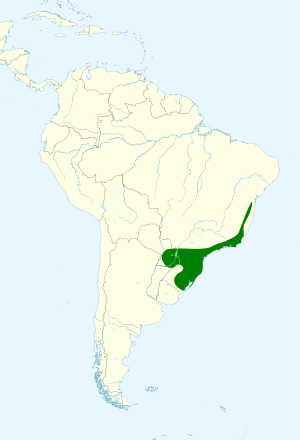Pileated parrot facts for kids
Quick facts for kids Pileated parrot |
|
|---|---|
 |
|
| Adult male | |
| Conservation status | |
| Scientific classification | |
| Genus: |
Pionopsitta
|
| Species: |
pileata
|
 |
|
The pileated parrot (Pionopsitta pileata) is a colorful bird found in South America. It belongs to the parrot family, Psittacidae, which includes African and New World parrots. You can find this parrot in countries like Argentina, Brazil, and Paraguay. It used to be called the "red-capped parrot," but that name caused confusion with a different Australian bird.
About the Pileated Parrot
The pileated parrot is the only species in its group, called Pionopsitta. This means it's quite unique! In Brazilian Portuguese, people sometimes call it "cuiú cuiú."
What Does the Pileated Parrot Look Like?
This parrot is about 20 to 22 centimeters (8 to 9 inches) long. It weighs between 98 to 120 grams (3.5 to 4.2 ounces).
Most of its body is green, with a slightly yellowish belly. The main flight feathers on its wings and the tips of its tail feathers are a dull blue color.
- Males: Adult male pileated parrots have a bright red forehead, the top of their head (crown), and areas around their eyes and ears.
- Females: Female parrots do not have any red. Instead, they might have a very light blue tint on their forehead and chest.
- Young Parrots: Young males have less red on their heads than adult males. Young females have less blue on their wings.
Where Do Pileated Parrots Live?
The pileated parrot lives in southeastern Brazil, stretching south into eastern Paraguay and Argentina's Misiones Province.
They mostly live in humid forests. However, they can also be found in slightly more open or drier forests. These areas often have many Araucaria trees. They also live in places where some trees have been cleared. You can find them from sea level up to about 1,500 meters (4,900 feet) high.
Pileated Parrot Behavior
How Do Pileated Parrots Move?
These parrots sometimes travel between areas that are further inland and those closer to the coast. They are known to be quite "nomadic," meaning they move around a lot, especially in places like Intervales State Park in Brazil.
What Do Pileated Parrots Eat?
Scientists are still learning a lot about what pileated parrots eat. We know they feed on fruits and seeds from different types of plants. They also eat the bark of Eucalyptus trees.
Pileated Parrot Reproduction and Life Cycle
The nesting season for the pileated parrot isn't fully known, but it seems to include November. These birds build their nests in holes found in trees.
In the wild, a female parrot usually lays two eggs. However, in zoos or special breeding centers, they often lay three or four eggs. When kept in captivity, only the female parrot sits on the eggs. She incubates them for about 24 days. The young birds are ready to leave the nest about 52 to 54 days after they hatch.
What Sounds Do Pileated Parrots Make?
The pileated parrot has a very high, sharp call that sounds like "tjeéreweét." When they are flying, their call is a high "tjer-tjer'tjer- -."
Status of the Pileated Parrot
The IUCN (International Union for Conservation of Nature) has listed the pileated parrot as a species of "Least Concern." This means that, for now, they are not considered to be in immediate danger of disappearing.
Even though they live in a fairly large area, we don't know exactly how many pileated parrots there are. Experts believe their numbers might be going down. No major threats have been found right away. However, their numbers have been greatly reduced because their forest homes are being lost. They still survive in good numbers where there is plenty of forest cover.
See also
 In Spanish: Lorito carirrojo para niños
In Spanish: Lorito carirrojo para niños


